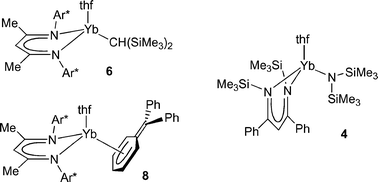Heteroleptic β-diketiminatoytterbium(II) complexes [{Yb(L)(μ-I)(thf)}2] [1: L = {N(Ar*)C(Me)}2CH = L1, 2: L = {N(SiMe3)C(Ph)}2CH = L2; Ar* = C6H3iPr2-2,6] were prepared by a salt elimination [from YbI2(thf)2 and KL] or by a ligand redistribution [from YbI2(thf)2 and YbL2] reaction. Complexes 1 and 2 were convenient precursors to some new Yb(II) heteroleptic compounds. Thus, reaction of 1 and 2 with KN(SiMe3)2 yielded the mononuclear amido compounds [Yb(L){N(SiMe3)2}(thf)] (3: L = L1 and 4: L = L2). Similarly, 1 with K{N(H)Ar*} gave [Yb(L1){N(H)Ar*}(thf)] (5). Complex 3 was also obtained via a protolytic reaction of [Yb{N(SiMe3)2}2(thf)2] with HL1 at an elevated temperature. Treatment of 1 with slightly less than a stoichiometric amount of K{CH(SiMe3)2} afforded [Yb(L1){CH(SiMe3)2}(thf)] (6), while using even a small excess of the alkyl reagent resulted in the deprotonation of the β-diketiminato ligand and the formation of the known dimer [{Yb(L3)(thf)}2] [7, L3 = ![[N with combining macron]](https://www.rsc.org/images/entities/char_004e_0304.gif) (Ar*)C(Me)C(H)C(
(Ar*)C(Me)C(H)C(![[C with combining macron]](https://www.rsc.org/images/entities/char_0043_0304.gif) H2)N(Ar*)]. Compounds 1 or 2 reacted with KCPh3 in thf yielding [Yb(L1){η5-C6H5CPh2}(thf)] (8) or [Yb(CPh3)2(thf)2] (9), respectively; the latter has two differently coordinated CPh3 ligands. The molecular structures of 1, 2, 4, 5, 6, 8 and 9 were determined by X-ray diffraction.
H2)N(Ar*)]. Compounds 1 or 2 reacted with KCPh3 in thf yielding [Yb(L1){η5-C6H5CPh2}(thf)] (8) or [Yb(CPh3)2(thf)2] (9), respectively; the latter has two differently coordinated CPh3 ligands. The molecular structures of 1, 2, 4, 5, 6, 8 and 9 were determined by X-ray diffraction.

You have access to this article
 Please wait while we load your content...
Something went wrong. Try again?
Please wait while we load your content...
Something went wrong. Try again?
![[N with combining macron]](https://www.rsc.org/images/entities/char_004e_0304.gif) (Ar*)C(Me)C(H)C(
(Ar*)C(Me)C(H)C(![[C with combining macron]](https://www.rsc.org/images/entities/char_0043_0304.gif) H2)N(Ar*)]. Compounds 1 or 2 reacted with KCPh3 in thf yielding [Yb(L1){η5-C6H5CPh2}(thf)] (8) or [Yb(CPh3)2(thf)2] (9), respectively; the latter has two differently coordinated CPh3
H2)N(Ar*)]. Compounds 1 or 2 reacted with KCPh3 in thf yielding [Yb(L1){η5-C6H5CPh2}(thf)] (8) or [Yb(CPh3)2(thf)2] (9), respectively; the latter has two differently coordinated CPh3 

 Please wait while we load your content...
Please wait while we load your content...